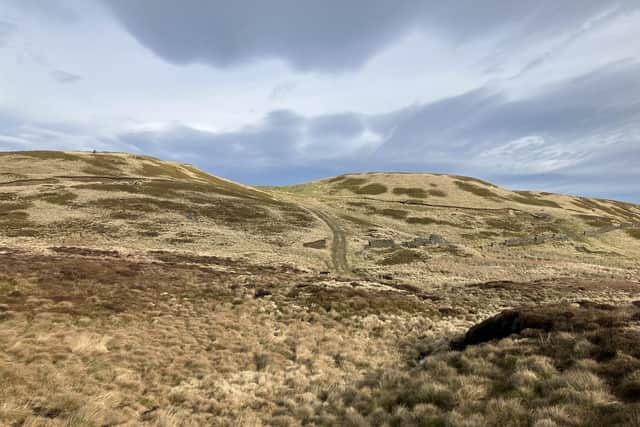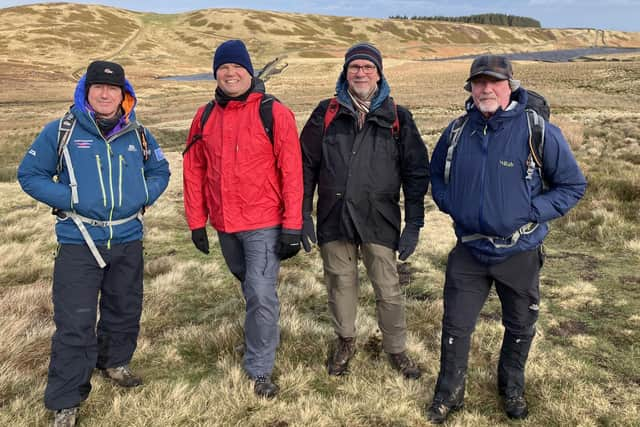Inside the long-term project to revitalise the Peak District and Pennines
A mammoth project to restore the Peak District’s “globally significant” landscape is well underway, and we headed to Hade Edge to see the progress being made by Moors for the Future.
Moors for the Future (MFTF) is a not-for-profit partnership working since 2003 to revive the Peak District and part of the Pennine moorland, which became the most degraded upland landscape in Europe due to 200 years of heavy pollution resulting from the industrial revolution, among other factors.
Advertisement
Hide AdAdvertisement
Hide AdOn a chilly Wednesday lunchtime, we met with two managers at the partnership – Christopher Dean and Tony Price – along with two councillors and members of the National Park Authority – Coun Charles Greaves (Kirklees) and Coun Andy Nash (Derbyshire Dales) – for a tour of the site near Snailsden Reservoir on the hills above Holmfirth.


Restoration of blanket bogs is central to the work of the MFTF. These bogs are essential habitats for wildlife, absorb carbon, and act as a natural flood management system.
However, the bogs have become heavily damaged over many years, leaving peat exposed and sites vulnerable to wildfires and unable to support natural biodiversity. There were 400 serious wildfires in the Peak District alone between the 1970s and early ’00s.
Coal fumes from industry seriously damaged the sphagnum moss in the area, with much of it being wiped out. The subsequent rarity of this moss signifies the start of the problem, as it is key to protecting peat and allowing blanket bogs to be self-sustainable.
Advertisement
Hide AdAdvertisement
Hide AdIn addition, the exposure to pollutants has left peat more acidic than lemon juice. This means that almost no plants would germinate in the soil and work needed to be undertaken to reduce the acidity.


The Clean Air Bill removed coal fumes from the air, meaning that MFTF has been able to reintroduce sphagnum moss and native plants. However, MFTF’s work is not over yet as the soil is considered to be contaminated and the area remains prone to wildfire.
MFTF has already transformed over 45 square kilometres of land, with visible results – Black Hill, the highest point in West Yorkshire, located near Holmfirth, is now revegetated, having once been a bleak and barren sight.
The partnership works in the Peak District, which stretches from West Yorkshire all the way down to Derbyshire, as well as the South and West Pennine moors in Lancashire and Calderdale.
Advertisement
Hide AdAdvertisement
Hide AdWhen asked for the one thing each attendee thought the public should know about the project, Christopher Dean, Partnership Manager for MFTF Partnership, said: “I think the most important thing that the surrounding public need to understand about their upland environment is that it gives them such a huge amount that people are probably at the moment not entirely aware of.
“If you live anywhere here, then your drinking water comes from more or less outside your door somewhere, so the value of it to your everyday lives is huge and people are probably not as aware of that as they should be.”
Coun Charles Greaves (Independent, Holme Valley North), Peak District National Park Authority Member said: “Restoring the Moors is so important to our area because of the outcomes it delivers – it is 10 for the price of one and I only wish that they could do more, sooner. It is a globally significant environment and it is our best opportunity to contribute towards the natural environment, and to undo the centuries of damage that industry has caused.
“Restoring the Moors helps to retain the massive amounts of carbon that is stored there, as well as to draw in more carbon in the future. But it also supports wildlife and farming, it improves water quality and by rewetting the Moors it helps to store water to reduce flooding and fire risk, and it also reduces the risk of drought too.
Advertisement
Hide AdAdvertisement
Hide Ad“It visually improves the land, it makes it a nicer environment for people to visit and it acts as a physical example of what land management can achieve, at a fraction of the cost of civil engineering projects.
“Moorland restoration really is important work – whilst it may seem low key, it plays a vital part in changing our environment for the better.”
Tony Price, Business Development Manager for MFTF Partnership, said: “I think the most important takeaway for the public from this is that they need to realise that sat on their doorstep is an iconic landscape that is seven times rarer than rainforest and that in itself if a healthy blanket bog can go a long way to reducing the effects of climate change as we go forwards into the future.”
Coun Andy Nash, District Councillor for Derbyshire Dales: “It’s easy to visit the peak park and look at the moors and think how wonderful they are, but in truth, they actually did a lot of work to keep them going. And if we don’t appreciate them and put the work into it, we’re going to have a carbon problem and water problem for the future.”
To learn more about the partnership and how you can get involved, visit: https://www.moorsforthefuture.org.uk/
Comment Guidelines
National World encourages reader discussion on our stories. User feedback, insights and back-and-forth exchanges add a rich layer of context to reporting. Please review our Community Guidelines before commenting.